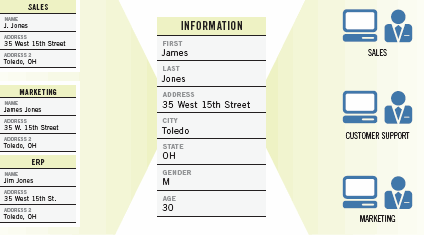LESSON - Getting Started with Master Data Management
By Tina Wefer, Senior Manager, Product Marketing, Initiate Systems
Think of it as a highly accurate tool for making decisions and gaining insight about customers, products, employees, vendors, and other aspects of a business with laserlike precision. Master data management (MDM) systems generate and maintain an enterprisewide “system of record” that contains consistent, reliable information necessary to perform vital business functions. MDM has become an increasingly hot topic due to its ability to increase revenue, reduce costs, improve customer service, and make it easier to comply with regulations.
Though experts agree that the holy grail of MDM is a solution that unites data from diverse applications (e.g., sales, support, billing, marketing), lines of business, and channels, developing such an advanced IT architecture typically takes years, is extremely expensive, and virtually eliminates the chance for a fast return on investment (ROI). Some companies approach MDM as a data warehousing or system consolidation project, assuming they need to merge all data before taking advantage of it. A more reasonable approach is to implement a phased MDM strategy that enables enterprises to develop an effective working model for future development, while allowing a fast ROI on the first phase of the project. Consider starting with a registry or hybrid implementation; by leaving the data where it currently resides rather than consolidating it into one master source, you can achieve quicker implementations and quicker time to value. You can evolve to a transactional implementation over time if your needs dictate.

Figure 1: Master data management systems generate and maintain an enterprisewide “system of record” that containsconsistent, reliable information necessary to perform vital business functions. (View larger image.)
Knowing Where to Start
While businesses can choose from a number of data domains on which to focus, customer data is a natural starting point for an incremental MDM approach for many companies. According to a 2006 research study by TDWI, information about customers is the data most requested by users. An incremental customer-centric approach to MDM can significantly enhance customer service efforts by providing more accurate and complete customer data and reducing the risk of human error. Access to accurate, real-time master customer data gives sales, marketing, and service teams a better view of customers and their preferences, enabling them to provide targeted offerings and personalized service that improve customer relations.
Selling to Management
When selling a plan of attack to executives, remember they need to see a return on investment in a relatively short time frame. Make it easy for executives to envision the value and understand long-term goals while focusing on short-term gains. Following are some tips:
- Sketch the big picture, but concentrate on short-term gain
- Identify three projects that overcome inertia and demonstrate tangible business value
- Build detailed business cases with projects that people can rally around
- Demonstrate an understanding of effects on major business processes
- Evaluate projects from both an IT and business case point of view
- Demonstrate short-term gains to sell longterm opportunities
- Commit to realistic dates as you plan
Final Thoughts
The power of MDM derives from its ability to manage data across a company’s entire information infrastructure. However, many companies lack the means or resolve to implement MDM at once across all applications, data sources, and physical locations in their enterprise. For these organizations, a phased approach is more cost effective. And for a good many companies, the first launching point for MDM should be the customer realm. Businesses that successfully implement a customer-centric MDM solution in one area of the company can then move on to other areas as business requirements demand, giving them the intelligence they need to improve business processes, build revenues, and increase competitiveness in the years ahead.